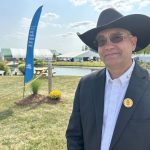Large-scale nuclear power plants aren’t going to be set up in Saskatchewan anytime soon.
The government last week said it would not accept a recommendation from its Uranium Development Partnership to speed plans for nuclear power, or a proposal from Bruce Power to construct a large plant.
“We are not endorsing a specific large-scale nuclear power proposal at this time,” said energy and resources minister Bill Boyd Dec. 17.
However, he did not rule out a 1,000 megawatt plant sometime in the future.
Read Also

Trade war may create Canadian economic opportunities
Canada’s current tariff woes could open chances for long-term economic growth and a stronger Canadian economy, consultant says — It’s happened before.
Smaller reactors are still possible, and he said the government would encourage uranium mining and value-added research. SaskPower will consider nuclear as an option for additional power generation after 2020.
The province also stands behind its joint application to the federal government with the University of Saskatchewan to establish a nuclear research centre that would produce medical isotopes.
Although the government has said it would not get involved in storing nuclear waste in Saskatchewan, Boyd said it would consider proposals from communities or First Nations groups that want to host such facilities.
“That does not mean that it would be granted approval,” he said of potential applications, adding that while one First Nations group expressed interest, there have been no formal proposals.
Saskatchewan does not need a 1,000 megawatt reactor as proposed by Bruce Power because its power needs increase incrementally and can be handled the same way.
SaskPower has asked for proposals for 200 megawatts of wind power to meet the next incremental demand, Boyd said. However, the corporation doesn’t consider wind power capable of meeting base load demand.
Base load is the level of power that is always required. Peak load is the fluctuation of electricity use, which can vary by the season or by the time of day.
“We think (wind power) can only be included into peaking, so you have to start looking at other sources,” the minister said.
Small nuclear reactors may be part of power generation after 2020, but the only way a 1,000 megawatt plant would be cost-effective would be if power was exported.
At a cost of $10 to $20 billion, the price for consumers without an export program would be too high, Boyd said, adding there is currently no export demand.
“If there were small reactors that could meet the regulatory frameworks going forward, it’s something that we think meets more with the demand picture that we see in Saskatchewan in the future,” he said.
The province generates about 60 percent of its power from coal.
The UDP report issued in October 2008 suggested that uranium exploration and mining would add $4.2 billion to the provincial economy over 15 years.
The Alberta government last week released results of its consultation on nuclear power.
According to a news release, 45 percent of those polled wanted power plants considered on a case-by-case basis. Nineteen percent said the province should encourage proposals, but 27 percent said the province should oppose proposals.
“Albertans have told us that we shouldn’t be closed to new generation technologies that could provide clean, low-emission power,” said energy minister Mel Knight. “At the same time Albertans have identified concerns with nuclear power that potential future applicants will need to fully address.”
The concerns include health, environment and safety.
Boyd said the difference between the two provinces is that the Alberta government regulates the utilities but doesn’t own them.















